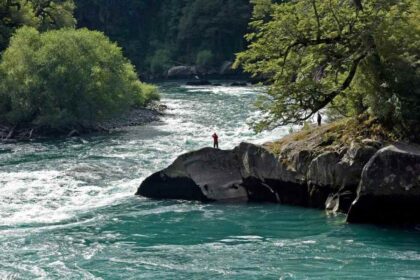A sweeping set of budget cuts proposed by the Trump administration could dismantle one of the most crucial and longstanding climate research programs in the world — the continuous tracking of atmospheric carbon dioxide levels by the National Oceanic and Atmospheric Administration (NOAA). Scientists warn that such a move would not only sever a 60-year scientific legacy but also significantly impair the global effort to understand and mitigate the accelerating climate crisis.
According to NOAA’s latest climate report, carbon dioxide concentrations in the Earth’s atmosphere reached their highest level ever recorded last year. These findings were drawn from a sophisticated, multi-decade monitoring program that has meticulously collected and analyzed air samples from around the globe. This program, scientists argue, forms the very backbone of our current understanding of human-driven climate change.
But leaked budget documents and growing concern within the scientific community suggest that this vital initiative is now hanging by a thread.
A Legacy in the Balance: From Keeling Sr. to Keeling Jr.
The foundation of NOAA’s carbon monitoring effort traces back to the late 1950s, when Professor Charles David Keeling, then a young researcher, began measuring atmospheric CO₂ concentrations from Hawaii’s Mauna Loa Observatory. His results revealed a steady upward climb in CO₂ levels, pioneering what is now known as the “Keeling Curve.” The curve, which has continued uninterrupted for more than six decades, provides a stark visual of the planet’s increasing carbon burden.
Charles Keeling’s research was groundbreaking, as it provided the first clear evidence that human activities — especially the burning of coal, oil, and natural gas — were directly contributing to the buildup of greenhouse gases. His early warnings even reached the White House, co-authoring a 1965 federal science report that blamed fossil fuel emissions for rising carbon levels.
Today, that mission is carried on by his son, Professor Ralph Keeling, at the Scripps Institution of Oceanography at the University of California, San Diego. From his lab in La Jolla, Ralph Keeling continues to oversee the collection and analysis of air samples shipped from remote locations worldwide — a process essential to maintaining the scientific integrity of the original curve.
“My father never pushed me to follow in his footsteps,” Ralph Keeling said in a recent interview. “But he inspired me by what he did. The work is more important now than ever.”
Trump-Era Cuts Raise Deep Concern
In a climate where science funding has increasingly become a political battleground, the Trump administration’s proposed NOAA cuts have set off alarms among climate researchers. According to internal documents and environmental watchdogs, the budget proposal calls for eliminating funding for NOAA’s global carbon sampling program. That program underpins the very data sets upon which climate models, international agreements, and emissions policy decisions are built.
Ralph Keeling and other experts say the consequences of ending this research would be severe.
“It would be a big blow if that work stopped,” Keeling explained. “Not just for me personally, but for the community and for the world at large. These measurements form the basis of how we understand the changing climate.”
NOAA’s air sampling operations stretch far beyond Hawaii. From the Arctic Circle to the Southern Hemisphere, air samples are carefully collected using vacuum flasks and shipped back to the Earth System Research Laboratory in Boulder, Colorado. There, they undergo rigorous analysis for trace gases, including CO₂.
International partners, such as the Norwegian Institute for Air Research, also contribute to the program, helping ensure measurement accuracy and consistency across nations. “Without this program, we lose the standard against which many other global CO₂ measurements are calibrated,” said Ove Hermansen, a Norwegian researcher.
The Power and Tragedy of the Keeling Curve
The Keeling Curve remains a hauntingly elegant line chart — simple in form, devastating in implication. It shows the relentless increase of atmospheric CO₂ over time, now surpassing 420 parts per million — a level not seen in millions of years.
“It’s beautiful data, but it’s also sad,” Ralph Keeling noted. “That curve tells a story of our industrial civilization — of progress, yes, but also of enormous environmental cost.”
The curve is more than an academic exercise. It has become a global symbol for the urgency of addressing climate change. Climate accords such as the Paris Agreement and the Intergovernmental Panel on Climate Change (IPCC) reports frequently rely on long-term atmospheric data like that provided by NOAA’s monitoring efforts.
Ending the program now would not just disrupt scientific continuity — it would represent a major step backward in the fight against climate change.
What Happens If the Program Shuts Down?
The potential elimination of NOAA’s carbon monitoring program has led scientists to issue dire warnings about the ripple effects such a decision would trigger.
“Stopping a program like this is like turning off your headlights while driving down a dark, winding road,” Keeling said. “It doesn’t stop the danger. It just blinds you to it.”
Without continuous, standardized carbon monitoring, climate models lose reliability. Forecasts about temperature rise, sea-level changes, drought risk, and extreme weather events become increasingly speculative. Moreover, international climate bodies would lack trustworthy reference points for global carbon concentrations, potentially undermining global cooperation on emissions reductions.
Critics argue that cutting this program would amount to willfully sabotaging the scientific tools needed to navigate the future of our planet.
A Pattern of Climate Science Suppression?
The NOAA cuts are part of a broader trend during the Trump presidency, which saw environmental regulations rolled back, climate science marginalized, and scientific agencies pressured to alter or suppress findings. From withdrawing the U.S. from the Paris Climate Agreement to dismantling Obama-era emission policies, the administration has often positioned itself at odds with mainstream climate science.
While the White House has yet to officially comment on the proposed NOAA cuts, the administration’s track record leaves little doubt about its intentions.
For the scientific community, the stakes are clear. Preserving the carbon monitoring program is not about partisan politics — it’s about maintaining the ability to see, measure, and respond to one of the most pressing threats facing humanity.
Conclusion
The proposed dismantling of NOAA’s CO₂ monitoring initiative signals a moment of reckoning. Will the United States continue to lead in climate science, or will it turn away from a legacy of empirical observation and global stewardship?
Professor Ralph Keeling, like his father before him, believes in the power of data to illuminate truth. But even he admits that data alone is not enough — it must be seen, understood, and acted upon.
“This isn’t just about science,” Keeling said. “It’s about whether we’re going to keep paying attention to the signals our planet is sending us. The data is the message. But will we listen?”
If the answer is no, the consequences won’t merely be academic. They will be real, measurable, and irreversible.



